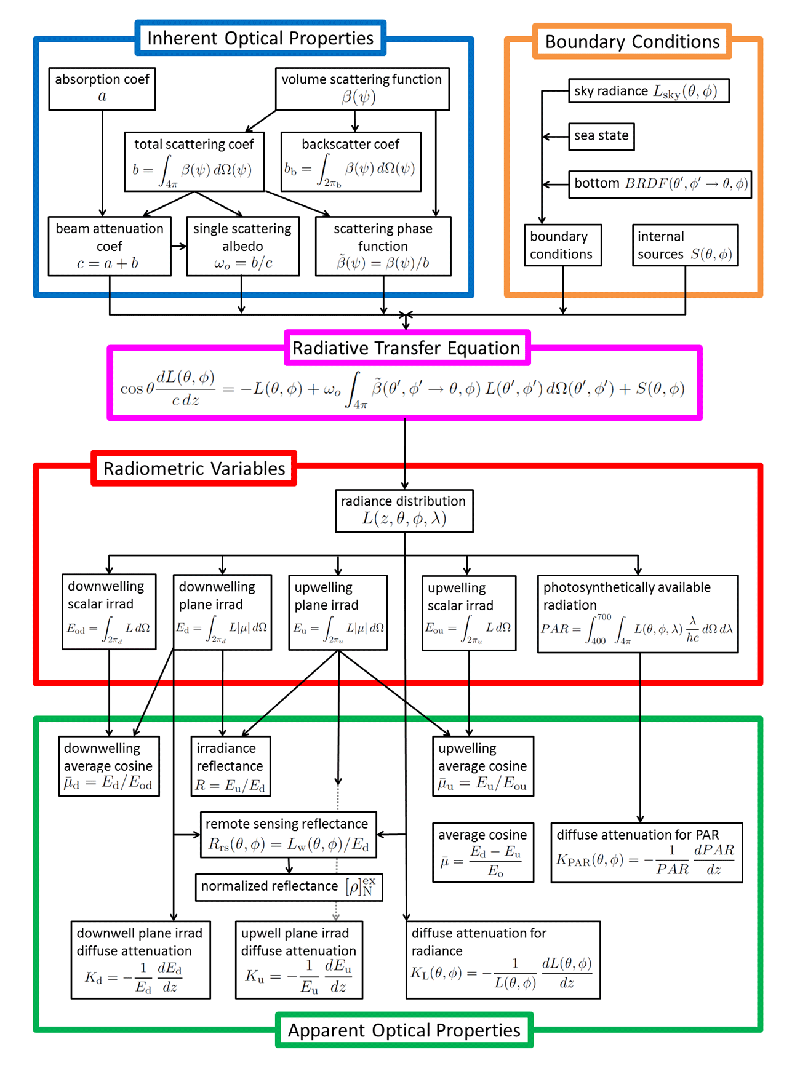Page updated:
January 23, 2021
Author: Curtis Mobley
View PDF
Introduction
The Light and Radiometry chapter explains how to describe light quantitatively. This chapter now explains how to describe and measure the optical properties of the material medium through which the light propagates. The first pages define and discuss inherent optical properties (IOPs), which are properties of a medium that do not depend on the ambient light field in the medium. The IOPs are various measures of the absorption and scattering properties of a water body. The subsequent pages then discuss apparent optical properties (AOPs). The AOPs are properties of a medium that (1) depend on both on the medium (the IOPs) and on the geometric (directional) structure of the ambient light field, and (2) display enough regular features and stability to be useful descriptors of the water body. Commonly used AOPs are various reflectances, average cosines, and diffuse attenuation coefficients. All of these quantities are defined and illustrated in this chapter. The IOPs and AOPs are mutually exclusive descriptors of optical properties, that is, something cannot be both an IOP and an AOP. However, there are other measures of the optical state of a water body that are neither an IOP nor an AOP. In particular, the various irradiances give information about the optical properties of a water body, but they are neither IOPs nor AOPs—they are radiometric variables. The radiative transfer equation, which connects the optical properties of the water body and the light within the water, is developed in the chapter on Radiative Transfer Theory.
Figure 1 shows the most commonly used IOPs, AOPs, radiometric variables, and their relationships. This figure shows that the absorption coefficient and the volume scattering function (VSF) are at the “top” of the IOP family. All other IOPs, such as the scattering and beam attenuation coefficients, can be derived from the absorption coefficient and the VSF. The IOPs are inputs to the radiative transfer equation (RTE), along with with boundary conditions that specify the radiance incident onto a water body and how radiance is transmitted through the sea surface and reflected by the surface and bottom. The IOPs along with the boundary conditions are needed to solve the RTE for the radiance distribution. If the radiance distribution is known, then all other radiometric variables (various irradiances) can be computed, as can the AOPs.
Note that radiometric variables such as the various irradiances are not AOPs. Irradiances certainly depend on the radiance and on the IOPs, but they fail the requirement of being stable enough to be useful descriptions of the water body. For example, if the sun goes behind a cloud, the irradiances and can change by an order of magnitude within seconds, but the water body itself remains the same. However, the ratio remains almost unchanged. As we will see, does contain useful information about the water body itself, regardless of the ambient lighting conditions. is thus a good candidate to be called an AOP.
Natural waters, both fresh and saline, are a witch’s brew of dissolved and particulate matter. These solutes and particles are both optically significant and highly variable in kind and concentration. Consequently, the optical properties of natural waters show large temporal and spatial variations and seldom resemble those of pure water.
The great variability in the optical properties of natural waters is the bane of those who desire precise and easily tabulated data or simple models. However, the coupling between constituent properties and optical properties implies that optical measurements can be used to deduce information about aquatic ecosystems. Indeed, it is the connections between the optical properties and the biological, chemical and geological constituents of natural waters that define the critical role of optics in aquatic research. For just as optical oceanography utilizes results from the biological, chemical, geological and physical subdisciplines of limnology and oceanography, so do those subdisciplines incorporate optics. This synergism is seen in such areas as biological oceanography, marine photochemistry, mixed-layer thermodynamics, lidar bathymetry, underwater visibility, and “ocean color” remote sensing of biological productivity, sediment load, pollutants, or bathymetry and bottom type.
The goal of this chapter is to survey the bulk optical properties of natural waters. The chapter closes with an overview of various schemes for classifying natural waters. The reasons why the various optical properties have their observed values are discussed in other chapters. However, the unseverable connections between optics and biology, chemistry, and geology will still be obvious.


 See comments posted for this page and leave your own.
See comments posted for this page and leave your own.